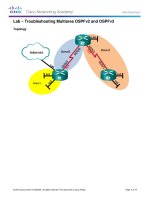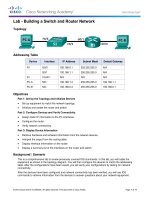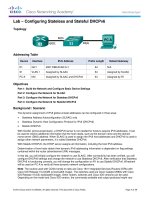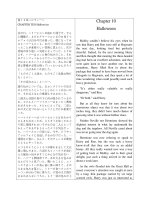10 starting a switch kho tài liệu bách khoa
Bạn đang xem bản rút gọn của tài liệu. Xem và tải ngay bản đầy đủ của tài liệu tại đây (1.37 MB, 38 trang )
Ethernet Switch
BSCI v3.0—2-1
Network Congestion
High-performance PCs
More networked data
Bandwidth-intensive applications
Bridges
Operate at Layer 2 of the OSI model
Forward, filter, or flood frames
Have few ports
Are slow
LAN Switch
High port density
Large frame buffers
Mixture of port speeds
Fast internal switching
Switching modes:
– Cut-through
– Store-and-forward
– Fragment-free
LAN Switch Features
Switches Supersede Bridges
Operate at Layer 2 of the OSI model
Forward, filter, or flood frames
Have many ports
Are fast
Ethernet Switches and Bridges
Address learning
Forward/filter decision
Loop avoidance
Transmitting Frames
Cut-Through
• Switch checks destination
address and immediately
begins forwarding frame.
Fragment-Free
• Switch checks the first 64
bytes, then immediately
begins forwarding frame.
Store and Forward
Complete frame is
received and checked
before forwarding.
MAC Address Table
• Initial MAC address table is empty.
Learning Addresses
• Station A sends a frame to station C.
• Switch caches the MAC address of station A to port E0 by
learning the source address of data frames.
• The frame from station A to station C is flooded out to all ports
except port E0 (unknown unicasts are flooded).
Learning Addresses (Cont.)
• Station D sends a frame to station C.
• Switch caches the MAC address of station D to port E3 by learning
the source address of data frames.
• The frame from station D to station C is flooded out to all ports
except port E3 (unknown unicasts are flooded).
Forward Frames
• Station A sends a frame to station C.
• Destination is known; frame is not flooded.
Filtering Frames
• Station A sends a frame to station B.
• The switch has the address for station B in the MAC
address table.
Broadcast and Multicast Frames
• Station D sends a broadcast or multicast frame.
• Broadcast and multicast frames are flooded to all ports
other than the originating port.
Symmetric switching
A symmetric switch provides switched connections between ports with the
same bandwidth.
Asymmetric switching
An asymmetric LAN switch provides switched connections between ports of
unlike bandwidth, such as a combination of 10 Mbps and 100 Mbps ports.
Asymmetric switching enables more bandwidth to be dedicated to the server
switch port in order to prevent a bottleneck.
The Hierarchy of Connectivity
Loops
Ethernet LANs
Starting a Switch
BSCI v3.0—2-19
Initial Startup of the Catalyst Switch
• System startup routines initiate switch software.
• Initial startup uses default configuration parameters.
Catalyst 2960 Switch LED Indicators
Initial Bootup Output from the Catalyst 2960
Switch
Initial Configuration of the Catalyst 2960
Switch Using Setup
Logging In to the Switch and Entering the
Privileged EXEC Mode
Configuring the Switch
Configuration modes:
Global configuration mode
– SwitchX#configure terminal
– SwitchX(config)#
Interface configuration mode
– SwitchX(config)#interface fa0/1
– SwitchX(config-if)#









